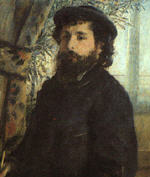
In 1890 Monet had bought a strip of marshland across the road from his house and flower garden, through which flowed a tributary of the Epte. By diverting this stream, he began to construct a water-lily garden. Soon weeping willows, iris, and bamboo grew around a free-form pool, clusters of lily pads and blossoms floated on the quiet water, and a Japanese bridge closed the composition at one end. By 1900 this unique product of Monet's imagination (for his Impressionism had become more subjective) was in itself a major work of environmental art--an exotic lotus land within which he was to meditate and paint for more than 20 years. The first canvases of lilies, water, and the Japanese bridge were only about one yard square, but their unprecedented open composition, with the large blossoms and pads suspended as if in space, and the azure water in which clouds were reflected, implied an encompassing environment beyond the frame. This concept of embracing spatiality, new to the history of painting and only implicit in the first water-lily paintings, was expanded by 1925 into a cycle of huge murals to be installed in Paris in two 80-foot oval rooms in the Orangerie of the Tuileries. These were described in 1952 by the painter André Masson as "the Sistine Chapel of Impressionism." This crowning achievement of Monet's long, probing study of nature--his striving to render his impressions, as he said, "in the face of the most fugitive effects"--was not dedicated until after his death. The many large studies for the Orangerie murals, as well as other unprecedented and unique works painted in the water garden between 1916 and 1925, were almost unknown until the 1950s but are now distributed throughout the major private collections and museums of the world. Despite failing eyesight, Monet continued to paint almost until his death in 1926.